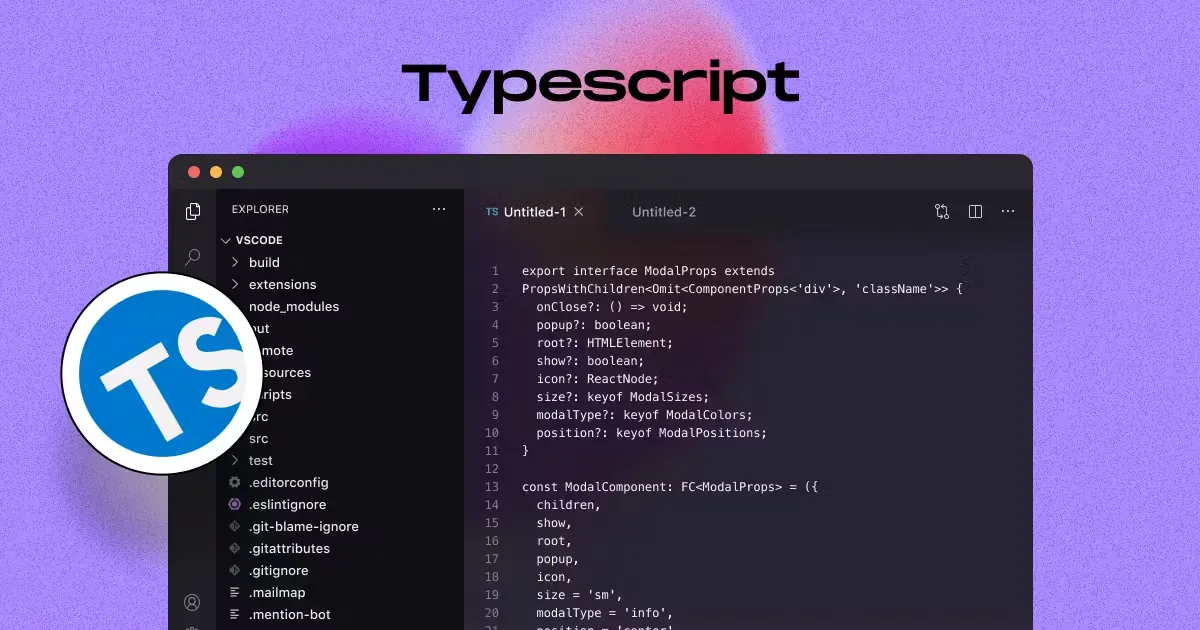In the ever-evolving world of web development, building complex, maintainable, and scalable applications is a major challenge. React has revolutionized how we build user interfaces, but as projects grow, managing data flow and catching bugs early becomes harder. This is where TypeScript shines, providing a robust "armor" for your JavaScript code.

The combination of TypeScript and React is no longer a rising trend—it's an industry standard, trusted by giants like Microsoft, Airbnb, and Slack. So why is this duo so powerful? Let's find out in this article.
What is TypeScript and Why Does It Matter?
Imagine JavaScript as a free-flowing, flexible, and powerful river, but sometimes hard to control and prone to "floods" (bugs). TypeScript, developed by Microsoft, is the system of levees and channels for that river.
Essentially, TypeScript is a superset of JavaScript. This means every valid JavaScript code is also valid TypeScript. The core difference TypeScript brings is its static type system.
Instead of waiting until runtime to discover you're adding a string to a number, TypeScript warns you right in your code editor.

Key benefits of adding static types:
- Early Bug Detection: Catch type errors as you type, not at runtime. This saves countless debugging hours.
- Self-Documenting Code: Type (
type) and interface (interface) definitions act as living documentation, helping teammates (and your future self) understand data structures and code intent. - Enhanced Developer Experience (DX): With strong editor support (like VS Code), you get smart autocomplete, parameter hints, and safer refactoring.
- Easier Maintenance and Scalability: In large projects, changing one part of the system can have ripple effects. TypeScript's type system gives you confidence to refactor, ensuring your changes don't break other parts of the app.
Why is TypeScript the "Perfect Match" for React?
React is all about building reusable components and managing state. TypeScript takes this model to the next level.
1. Safe Props
In React, props are how parent components pass data to children. With plain JavaScript, it's easy to pass the wrong type (e.g., a string instead of a number), leading to hard-to-find bugs.
TypeScript solves this by letting you clearly define the "shape" of your props.
Example:
// Define prop types for UserCard
interface UserCardProps {
name: string;
age: number;
isActive: boolean;
}
// UserCard component in TypeScript
const UserCard = ({ name, age, isActive }: UserCardProps) => {
return (
<div>
<h3>{name}</h3>
<p>Age: {age}</p>
<p>Status: {isActive ? 'Active' : 'Inactive'}</p>
</div>
);
};
// Usage
<UserCard name="Alice" age={30} isActive={true} /> // ✅ Perfect!
// <UserCard name="Bob" age="twenty" isActive={false} />
// ❌ Immediate error! TypeScript will complain because 'age' must be a number, not a string.
2. Explicit State Management
Just like with props, React state also benefits from TypeScript's type system. When using the useState hook, you can specify exactly what type of data your state will hold.
import React, { useState } from 'react';
// Define a type for a User object
interface User {
id: number;
username: string;
}
const UserProfile = () => {
// TypeScript infers user is `User | null`
const [user, setUser] = useState<User | null>(null);
const fetchUser = () => {
// Simulate fetching data
setUser({ id: 1, username: 'dave' });
};
if (!user) {
return <button onClick={fetchUser}>Load User</button>;
}
// Here, TypeScript knows `user` is not null
// and you can safely access `user.username`.
return <h1>Welcome, {user.username}!</h1>;
};
3. Clear Event Handling
Ever been unsure what properties are on the event object in an onClick or onChange handler? TypeScript helps here too.
const MyInput = () => {
const handleChange = (event: React.ChangeEvent<HTMLInputElement>) => {
// As you type `event.`, VS Code will suggest `target`, `target.value`, etc.
console.log(event.target.value);
};
return <input type="text" onChange={handleChange} />;
}
With React.ChangeEvent<HTMLInputElement>, you're telling TypeScript this is a change event on an <input>, and it provides full type info for the event object.
Getting Started with TypeScript and React: Easier Than You Think
Today, starting a React project with TypeScript is super simple.
The Fastest Way: Create React App
The official React tool supports TypeScript out of the box. Just run:
npx create-react-app my-app --template typescript
This sets up a React project with everything TypeScript needs, including tsconfig.json and dependencies.
Adding TypeScript to an Existing Project
If you have an existing React project and want to migrate, you can add TypeScript fairly easily:
- Install dependencies:
npm install --save typescript @types/node @types/react @types/react-dom @types/jest - Create a
tsconfig.jsonfile: This is TypeScript's config file. You can create it manually or withnpx tsc --init. - Rename files: Start renaming files from
.jsxto.tsx(for files with JSX) and.jsto.ts(for plain logic files). - Add types: Gradually add type definitions for
props,state, and other variables in your project.
Advanced Patterns and Useful Tips
Once you're comfortable with the basics, you can explore TypeScript's deeper power in React.
-
Use
typeandinterface:interface: Usually for defining object shapes and componentprops. Can be extended.type: More flexible, can be used for primitives, union types (string | number), or more complex types.
-
Leverage Generics with Hooks: Create reusable, type-safe hooks. For example, a
useFetchhook can be defined to work with any data type you expect from an API.function useFetch<T>(url: string): { data: T | null; loading: boolean } { // ... fetch logic const [data, setData] = useState<T | null>(null) const [loading, setLoading] = useState(true) // ... useEffect to fetch return { data, loading } } // Usage const { data: userData } = useFetch<User>('/api/users/1') -
Context API with TypeScript: Define a clear type for your Context value to ensure every component using
useContextgets the right data.
Conclusion: A Worthwhile Investment
Learning and integrating TypeScript into your React workflow may require some initial effort. However, it's an investment with huge returns.
Combining React and TypeScript helps you write less buggy, more maintainable code, and greatly improves the developer experience and team collaboration. It turns risky code into a fortress, letting you confidently build complex, reliable web apps.
If you're serious about advancing your front-end career, mastering this powerful duo is your next step.
![[React Basics] Mastering the Most Important Design Patterns](/images/blog/react-design-patterns.webp)
![[React Basics] Mastering the useRef Hook in React with Practical Examples](/images/blog/useref-hook.webp)
![[React Basics] Managing Complex State with the useReducer Hook in React](/images/blog/usereducer-hook.webp)
![[React Basics] Optimizing Fetch API in React: Handling Asynchronous Data](/images/blog/fetch-api-in-react.webp)